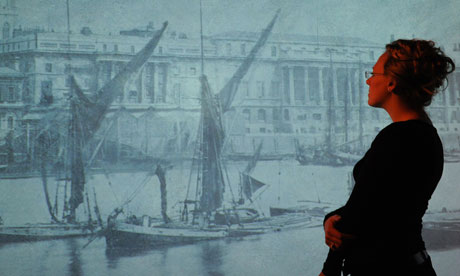
Alex Werner, curator of the first major museum show on Charles Dickens for more than 40 years, says one of his favourite exhibits is a small drawing that it would be easy for visitors to overlook: it shows a large heap of dust through which women are sifting in the hope of finding bits of metal or bone or anything else they can sell.
Dust collecting and sifting is just one illustration of life – and desperation – in Victorian London, reflected in the novels of Dickens and explored at the new Museum of London exhibition which opens to the public on Friday.
"In Victorian Britain, people would come to your door and buy all the dust and dirt you had collected in your house," said Werner. "There was quite a lot of money in rubbish."
Dust was also a central theme in Dickens's novel Our Mutual Friend, with Mr Harmon senior making his fortune from the dust heaps.
The exhibition shows how Dickens was the first great novelist of the modern city and how London was central to his works. Werner said: "I realised I had to create the right atmosphere and the right mood. Dickens was an insomniac and he used to pace the streets of London at night, writing his books in his head, so we wanted to give some sense of being in Dickens's mind."
The show features rarely seen manuscripts of his works including Great Expectations, David Copperfield and Bleak House but it also tries to give a sense of what Dickens's London looked like and will include numerous paintings of Victorian London.
One of the most important and most evocative is a large one by Luke Fildes. Applicants for Admission to a Casual Ward (1874) is a damning indictment of poverty and homelessness showing hungry crowds outside Whitechapel workhouse.
Other exhibits include Dickens's writing desk, his bank ledger and a wax doll of a girl dressed in the uniform of the Female Orphan Asylum at Lambeth, circa 1840, which shines a light on one of the writer's many strong opinions. He loathed uniforms, finding them patronising.
There are also a striking number of Victorian doorknockers, hardly surprising given what Dickens once wrote in Sketches by Boz: "Whenever we visit a man for the first time, we contemplate the features of his knocker with the greatest curiosity, for we well know, that between the man and his knocker, there will inevitably be a greater or less degree of resemblance and sympathy."
The exhibition is just one part of a Dickens-crazy 2012 with several events to mark the bicentenary of his birth.
Werner hopes the show will lead people to read some Dickens. "Hopefully we will encourage people to go and pick up a Dickens book. It is so easy to just watch something on TV but I hope with people seeing the manuscripts that they go away and read some of his work."

